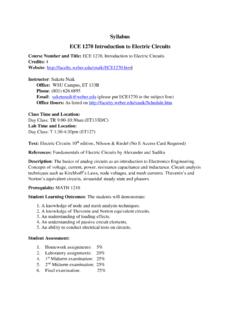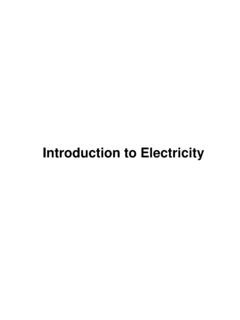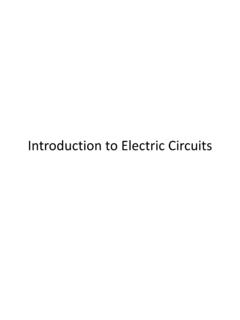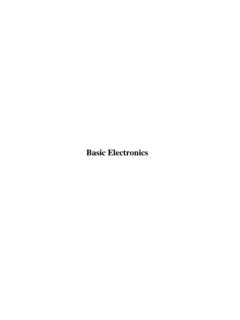Transcription of Fundamentals of Electric Circuits
1 Fundamentals of Electric 12/2/11 5:00 PM Page 1 PART ONEDC CircuitsOUTLINE1 Basic Concepts2 Basic Laws3 Methods of Analysis4 circuit Theorems5 Operational Amplifiers6 Capacitors and Inductors7 First-Order Circuits8 Second-Order 12/2/11 12:20 PM Page 23 Basic ConceptsSome books are to be tasted, others to be swallowed, and some few tobe chewed and digested. Francis Baconchapter1 Enhancing Your Skills and Your CareerABET EC 2000 criteria ( ), an ability to apply knowledgeof mathematics, science, and engineering. As students, you are required to study mathematics, science, and engi-neering with the purpose of being able to apply that knowledge to thesolution of engineering problems.
2 The skill here is the ability to applythe Fundamentals of these areas in the solution of a problem. So howdo you develop and enhance this skill?The best approach is to work as many problems as possible in allof your courses. However, if you are really going to be successful withthis, you must spend time analyzing where and when and why you havedifficulty in easily arriving at successful solutions. You may be sur-prised to learn that most of your problem-solving problems are withmathematics rather than your understanding of theory. You may alsolearn that you start working the problem too soon.
3 Taking time to thinkabout the problem and how you should solve it will always save youtime and frustration in the I have found that works best for me is to apply our six-step problem-solving technique. Then I carefully identify the areaswhere I have difficulty solving the problem. Many times, my actualdeficiencies are in my understanding and ability to use correctly cer-tain mathematical principles. I then return to my fundamental mathtexts and carefully review the appropriate sections, and in some cases,work some example problems in that text. This brings me to anotherimportant thing you should always do: Keep nearby all your basicmathematics, science, and engineering process of continually looking up material you thought youhad acquired in earlier courses may seem very tedious at first; how-ever, as your skills develop and your knowledge increases, this processwill become easier and easier.
4 On a personal note, it is this very processthat led me from being a much less than average student to someonewho could earn a and become a successful by Charles 12/2/11 12:20 PM Page 34 Chapter 1 Basic Concepts+ CurrentLampBatteryFigure simple Electric + + 9 V (DC)Q1 Figure circuit of a radio circuit theory and electromagnetic theory are the two funda-mental theories upon which all branches of electrical engineering arebuilt. Many branches of electrical engineering, such as power, electricmachines, control, electronics, communications, and instrumentation,are based on Electric circuit theory.
5 Therefore, the basic Electric circuittheory course is the most important course for an electrical engineer-ing student, and always an excellent starting point for a beginning stu-dent in electrical engineering education. circuit theory is also valuableto students specializing in other branches of the physical sciencesbecause Circuits are a good model for the study of energy systems ingeneral, and because of the applied mathematics, physics, and topol-ogy electrical engineering, we are often interested in communicatingor transferring energy from one point to another. To do this requires aninterconnection of electrical devices.
6 Such interconnection is referredto as an Electric circuit , and each component of the circuit is known asan Electric circuitis an interconnection of electrical simple Electric circuit is shown in Fig. It consists of threebasic elements: a battery, a lamp, and connecting wires. Such a simplecircuit can exist by itself; it has several applications, such as a flash-light, a search light, and so complicated real circuit is displayed in Fig. , representing theschematic diagram for a radio receiver. Although it seems complicated,this circuit can be analyzed using the techniques we cover in this goal in this text is to learn various analytical techniques andcomputer software applications for describing the behavior of a circuitlike 12/2/11 12.
7 20 PM Page and Current5 TABLE basic SI units and one derived unit relevant to this unitSymbolLengthmetermMasskilogramkgTime secondsElectric currentampereAThermodynamic temperaturekelvinKLuminous intensitycandelacdChargecoulombCTABLE SI 1810 1510 1210 9m10 610 310 210 1102103106109101210151018 Electric Circuits are used in numerous electrical systems to accom-plish different tasks. Our objective in this book is not the study ofvarious uses and applications of Circuits . Rather, our major concern isthe analysis of the Circuits . By the analysis of a circuit , we mean astudy of the behavior of the circuit : How does it respond to a giveninput?
8 How do the interconnected elements and devices in the circuitinteract?We commence our study by defining some basic concepts. Theseconcepts include charge, current, voltage, circuit elements, power, andenergy. Before defining these concepts, we must first establish a sys-tem of units that we will use throughout the of UnitsAs electrical engineers, we deal with measurable quantities. Our mea-surement, however, must be communicated in a standard language thatvirtually all professionals can understand, irrespective of the countrywhere the measurement is conducted. Such an international measurementlanguage is the International System of Units (SI), adopted by theGeneral Conference on Weights and Measures in 1960.
9 In this system,there are seven principal units from which the units of all other phys-ical quantities can be derived. Table shows the six units and onederived unit that are relevant to this text. The SI units are used through-out this great advantage of the SI unit is that it uses prefixes based onthe power of 10 to relate larger and smaller units to the basic shows the SI prefixes and their symbols. For example, thefollowing are expressions of the same distance in meters (m):Charge and CurrentThe concept of Electric charge is the underlying principle for explain-ing all electrical phenomena.
10 Also, the most basic quantity in an elec-tric circuit is the Electric all experience the effect of ,000,000 mm 600,000 m 600 12/2/11 12:20 PM Page 56 Chapter 1 Basic Concepts1 However, a large power supply capacitor can store up to C of + Figure current due to flow of electroniccharge in a convention is a standard way ofdescribing something so that others inthe profession can understand whatwe mean. We will be using IEEE con-ventions throughout this when we try to remove our wool sweater and have it stick toour body or walk across a carpet and receive a an electrical property of the atomic particles of which mat-ter consists, measured in coulombs (C).









